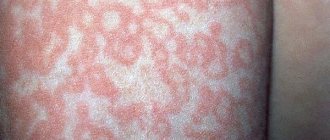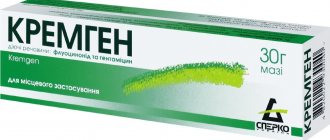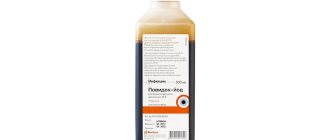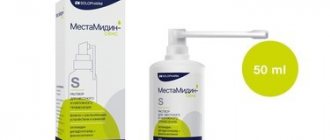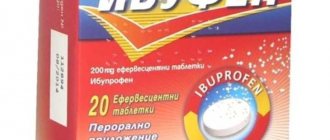Compound
The active ingredients in 100 ml of the drug include:
- 0.1 g - chlorhexidine bigluconate;
- 0.1 g - hexamidine diisothionate;
- 0.3 g - chlorocresol.
As additional ingredients, Citeal contains:
- 30% laurylamidobetaine;
- ethylenediaminetetraacetic acid;
- coconut oil fatty acid diethanolamide
- lactic acid;
- purified water;
- flavoring "coniferol".
Pharmacodynamics and pharmacokinetics
Citeal is an antiseptic drug, the pharmacological action of which is determined by the effects of the drugs included in its composition.
The combination of active substances of the drug has a mild antiseptic effect with bacteriostatic effects (but not bactericidal), and also exhibits antifungal and antitrichomoniacal activity.
Not absorbed when applied to intact skin.
The therapeutic effect of the drug lasts for 18 hours from the moment of a single application.
Pharmacological properties of the drug Citeal
Foaming solution intended for antiseptic treatment of skin and mucous membranes. The drug contains antibacterial active ingredients: chlorhexidine is a cationic antiseptic (synthetic biguanide); hexamidine - a cationic antiseptic from the diamidine group; chlorocresol is an antiseptic from the group of halogenophenols. Citeal has bacteriostatic activity, fungistatic and trichomonacid activity. Active regarding:
- gram-positive bacteria: Streptococcus, Staphylococcus species;
- gram-negative bacteria Proteus spp., Pseudomonas aeruginosa, E.coli, Gardnerella vaginalis, Neisseria gonorrhoeae;
- protozoa: Trichomonas vaginalis;
- fungi: Candida albicans, Trichophyton rubrum, Microsporum canis.
In vitro Herpes simplex virus (types I and II). The drug remains active in the presence of biological substances (pus, blood, serous fluid). Valid for 18 hours after application. Has an antipruritic effect. Does not stain or irritate when applied to the skin and mucous membranes, does not disturb the acid-base balance of the skin and vagina (pH = 5). Does not cause photosensitivity.
Indications for use
- treatment of the skin and mucous membranes for mycoses, ulcerative manifestations, eczema, diaper rash, acne, as well as dermatitis with concomitant infections of bacterial etiology;
- prevention and treatment of sexually transmitted infectious diseases (douching with Citeal is used for thrush, vaginitis, vulvitis, cervicitis , etc.);
- preoperative and pre-procedural treatment of the hands of medical personnel.
Reviews of the medicinal solution
Now you know what the drug “Citeal” is. The instructions (in gynecology this remedy is used most often) of this drug were also described above.
According to patient reviews, the solution in question works well in the treatment and prevention of various infectious diseases. It also often helps in the treatment of painful dermatological conditions. This remedy promotes rapid healing of ulcers and wounds. In addition, patients note the high efficiency of packaging and the pleasant aroma of the solution.
Contraindications
- hypersensitivity to any of the ingredients of Citeal;
- patient's predisposition to allergic diseases and reactions ;
- skin diseases of viral etiology;
- dermatitis.
Also, the use of the drug Citeal is not recommended:
- with antiseptic treatment of the skin at the injection site;
- during antiseptic treatment of the skin before invasive procedures that require surgical antiseptics (installation of an intravenous catheter , spinal puncture , etc.);
- when disinfecting surgical or other medical instruments;
- when washing wounds with a large surface or body cavities;
- during surgical operations on the central nervous system;
- for local ophthalmological procedures;
- when treating the external auditory canal, in case of perforation of the eardrum .
Side effects
As a rule, therapy using the drug Citeal is well tolerated. skin swelling, itching and/or burning sensation , hyperemia ) and allergic manifestations, including contact eczema, was noted
The development of side effects of Cyteal was most often observed with its repeated use.
When using the drug on areas of the skin with impaired integrity, systemic allergic reactions to chlorhexidine are possible, including the development of anaphylactic shock.
In some patients, the effect of hexamidine caused contact dermatitis , while the symptoms of the disease were different from classic contact eczema (rashes with infiltration, papulovesicular and papular formations in the form of hemispheres, localized or located in groups).
Douching for thrush
Douching for thrush is one of the most popular home treatment methods. The procedure involves washing the vagina using a special syringe. Manipulation requires the use of special medicinal or herbal solutions. Although, at first glance, douching is a straightforward and simple process, it can only be carried out in accordance with medical recommendations.
Features of douching
Just a few years ago, douching was considered one of the most effective methods of treating thrush. Treatment included the use of antifungal solutions. Today, many gynecologists consider this method not only harmful, but also unacceptable. In this regard, we will discuss all aspects.
Disadvantages of douching for thrush
- Douching without medical indications leads to a decrease in the body's resistance to various pathogens. The microenvironment in the vagina is disrupted, since some of the bacteria are simply washed away along with the stream of solution. It is important not to use the douching technique just in case or for preventive purposes.
- Thrush may be a consequence of vaginal dysbiosis, when a large number of lactobacilli simply disappear from the surface of the mucous membrane.
- Please note that you cannot independently extend the duration of the course of douching for thrush or vaginitis.
- World gynecological practice considers the douching procedure harmful to women's health. A stream of water, according to gynecologists, damages the epithelium of the uterus during erosion and aggravates dysbacteriosis.
- Immediately before visiting a gynecologist (even if the woman is sure that she has thrush), you should not douche. The procedure can greatly distort research results. Using a smear, it becomes almost impossible to diagnose the cause of the disease and make the correct diagnosis.
- Douching is contraindicated for pregnant women. The procedure can not only provoke the proliferation of pathogenic flora, but can also cause termination of pregnancy.
- Women during menopause should also not do douching due to excessive dryness of the vaginal walls.
- Acute inflammatory processes in the genital organs and menstruation periods (the risk of infection of the uterus increases) should also be considered a contraindication to the procedure.
- The first month after childbirth and abortion is a particularly dangerous time. The woman's reproductive system becomes very vulnerable. Naturally, you shouldn’t douche in such cases.
When to do douching?
The following conditions are considered indications for the procedure:
- Thrush (you can do douching to restore the acid-base balance of the mucous membranes);
- Cervical erosion;
- Chronic inflammatory processes of the vagina or cervix.
How to do douching: basic rules
If the doctor has prescribed a procedure, then you should prepare for it before starting treatment. To do this, purchase a syringe or an Esmarch mug. Before using the syringe, wipe it completely and rinse it with boiled water. Particularly noteworthy in Esmarch's mug are the details: the rubber tubes are wiped with alcohol, and the tip is boiled. A medicinal solution or herbal decoction is prepared according to the instructions or prescription of the doctor.
Using Esmarch's mug
The basis for the solution is boiled water at room temperature in an amount of 200-300 ml. Before douching, the mug must be hung at a height of 75 cm directly above the lumbar region. Before douching, a woman should lie down with her knees bent. It is better to carry out the procedure in the bathroom. The vagina is first lubricated with lanolin or petroleum jelly, and air is released from the tube. Carefully insert the tip 5 cm into the vagina and let a weak stream flow, gradually strengthening it. This douching lasts about 15 minutes. And then the woman remains alone for about 20-30 minutes.
Using a syringe
Treatment of thrush with this method is often carried out using a regular syringe. The procedure differs in that the solution is injected only into the vagina, and it does not enter the uterine cavity. An important point is the accuracy of inserting the syringe. Then there should be a gentle pressure (sharp pressure increases the risk of the solution getting into the uterus, which is extremely undesirable).
Some nuances
It is important to do douching correctly, so when carrying out the procedure you should pay attention to the following points:
- Before douching, be sure to wash your genitals;
- It is better if such treatment is carried out at night;
- Herbal solutions are pre-cooled to a comfortable warm temperature (if the solution is too hot, the risk of developing a deep type infection increases);
- Douching for thrush gives good results only in cases when it is carried out simultaneously with drug treatment;
- Thrush cannot be treated in this way unless recommended by a doctor.
Solutions for douching for thrush
Traditionally, astringent and anti-inflammatory agents are used for thrush. Some of them can be bought at the pharmacy and then used according to the instructions. The rest are prepared at home using readily available ingredients. Decoctions and infusions of herbs are also widely used for douching.
Pharmacy drugs
Hydrogen peroxide
This liquid is an antioxidant, therefore, in diluted form, it is used to combat many pathogens, including thrush pathogens. One tablespoon of hydrogen peroxide per half-liter jar of water is enough. This douching will help eliminate some of the symptoms of thrush (itching, burning).
Furacilin
This drug is not able to completely rid a woman of thrush, but it significantly alleviates the symptoms of the disease. Douching with furatsilin can relieve inflammation, eliminate burning and itching. The tablet is crushed and then dissolved in warm water (200 ml).
Potassium permangantsovka
This solution is a good antiseptic. For douching for thrush, a light pink liquid is prepared. The solution is prepared with great care. It must be carefully strained so that even the smallest grains are not caught. Otherwise, potassium permanganate will cause severe burns of the mucous membrane.
Boric acid
Helps change the acidity level in the vagina. Thrush pathogens cannot fully reproduce in an unfavorable atmosphere.
Chlorophyllipt
The pharmacy sells an alcohol solution with chlorophyllipt. For douching, take one tablespoon of the drug per liter of boiled water. You can not only douche with it, but also treat the genitals during the treatment of thrush.
Malavit
A herbal medicine that is easy to buy at any pharmacy. It not only kills various microorganisms, but also relieves swelling well. For 300 ml of water for douching, take 15 ml of Malavita. The course is no more than 5 days. It can also be used to prevent thrush (in this case it is added to the bath).
Miramistin
It is an effective remedy not only for thrush. It perfectly fights gram-positive and gram-negative aerobic and anaerobic bacteria. Miramistin kills those bacteria that provoke the development of sexually transmitted infections, yeast-like fungi, viruses, dermatophytes, ascomycetes. Thanks to Miramistin, if you have thrush, you can quickly restore the vaginal microflora. The medication is also used to prevent sexually transmitted diseases. Miramistin is allowed during pregnancy and lactation.
Chlorhexidine
This drug has a fairly wide spectrum of action, including antifungal properties, which makes its use advisable for the treatment of thrush. The solution is sold in the pharmacy chain in finished form. It is better to purchase it in a special bottle with a spout. In this case, the packaging serves as a syringe. It is important to remain quiet for some time after the procedure. The duration of the course should be prescribed by a gynecologist. In case of overdose, there is a high risk of developing vaginosis.
Home Remedies
Soda solution
One of the most popular douches for thrush; it is also effective for dysbacteriosis. For half a teaspoon of soda, 300 ml of water is enough (necessarily boiled and cooled to a comfortable temperature). Treatment lasts no more than 7 days.
Citeal, instructions for use (Method and dosage)
The drug Citeal is used exclusively externally.
For the prevention and treatment of various diseases, use an undiluted solution or a solution of Cyteal with water 1:10.
The drug solution is prepared immediately before use.
During therapy, applications are made daily, with an average course of treatment lasting 10-15 days.
For prevention, it is recommended to use the drug twice a week for 3-6 months.
After using Citeal, the application sites should be thoroughly rinsed with water.
An undiluted solution is used for: vulvitis , treatment of the hands of medical staff, fungal diaper rash , pityriasis versicolor , dermatophytosis of the feet (daily for therapy and 2 times a week for prevention).
At a dilution of 1:10 for: diaper rash in children, primary bacterial dermatoses (folliculitis, impetigo, furunculosis, carbunculosis), ulcers of the lower extremities, as well as in gynecology for fungal and microbial vaginitis (for therapy in the form of daily douching, with specific treatment, and 2 times a week in the form of douching, for prevention).
For cervicitis, acne, bacterial eczema and recurrent infectious diseases of the genital organs, both pure and diluted drugs can be used.
The instructions for douching with Citeal suggest diluting 2 caps of the drug in 200-250 ml of water, filling the syringe and performing the vaginal douching procedure; after 2-3 minutes, the process is repeated several times using plain water.
Iodinol is the best remedy for thrush in women
Women who have experienced unpleasant sensations due to candidiasis are ready to do anything to get rid of them faster. There are many drugs against the disease, but not all of them are effective. Iodinol has become increasingly used in this case. Although it is inexpensive, it quickly helps with thrush.
Inexpensive drug for the treatment of candidiasis
Doctors have long noticed that antibiotics are now less likely to have a positive effect. Most bacteria and fungi have learned to adapt to them. In addition, chemicals have side effects and undermine the weakened immunity of women. To destroy microorganisms, it is better to use birch tar, methylene blue, iodine and other inexpensive natural substances.
When treating infectious and inflammatory diseases, many remembered the previously popular medicine - Iodinol. But if in the middle of the 20th century this drug was in all gynecological offices, now it is difficult to find. It is now customary to get rid of candidiasis using modern means, which are expensive and sometimes ineffective. And only a few know that Iodinol for thrush is the best way for women to get rid of unpleasant sensations.
What is the drug
This is a dark blue alcohol solution, packaged in dark 100 ml bottles. It dissolves in water and smells distinctly of iodine. But unlike it, it is less toxic. This can be explained by its composition. The solution contains:
- polyvinyl alcohol;
- potassium iodide 0.9%;
- iodine 0.1%.
Thanks to this successful combination of components, it has a gentle effect on the mucous membrane and destroys only pathogenic microorganisms.
Useful action
Previously, Iodinol was often used against thrush in women. This is due to its strong antifungal effect. Yeast microorganisms cannot adapt to the effects of iodine and die upon contact with the solution.
In addition, the effectiveness of the drug is explained by other beneficial properties. It provides:
- anti-inflammatory effect;
- antiseptic effect;
- regenerates mucosal cells and accelerates metabolic processes.
Advantage of Iodinol
Photo of the drug Iodinol
Why is it better to use this drug when women experience vaginal discomfort?
- Its price is less than that of other antifungal drugs. A 100 ml bottle costs 30-60 rubles.
- A concentration of 1% can destroy all types of fungi.
- It quickly helps to cope with itching, burning and other symptoms.
- The drug fights infection on a par with strong antibiotics, but unlike them, it prevents relapses of the disease and does not reduce immunity.
- Does not irritate the sensitive mucous membrane and does not disturb the natural flora of the vagina.
Gynecologists often prescribe treatment for thrush with Iodinol, especially for mixed infections.
Efficiency and safety allows use in newborns. After all, the drug used to be present in maternity hospitals, but now modern medicines are used to treat the child.
How to use correctly
Treatment of thrush with Iodinol involves external use. It is important to dilute it correctly so as not to cause a burn to the mucous membrane and an increase in unpleasant symptoms. And if, for the treatment of skin infections and purulent wounds, gauze soaked in the drug is placed in their cavity, then the vagina can only be treated with a solution. Dilute in water at room temperature, since it evaporates strongly when hot. You can douche with this solution or wipe the vaginal walls with a roller dipped in it. Before this, it is advisable to remove plaque and discharge using hygienic procedures.
Methods of use
Douching with Iodinol for candidiasis in women
The instructions for use contain little information on how to use Iodinol. But when a doctor prescribes treatment, he explains in detail to the woman what to do:
- The first method is douching with a solution. It is diluted in the following proportion: a tablespoon per glass of water, and inserted into the vagina. This treatment is the most effective, since all areas of the mucous membrane are treated.
- How else can I use Iodinol? The second way is to soak a tampon in the solution and insert it into the vagina.
- It is possible to treat thrush in a child's mouth. Children have a sweet tooth, and mushrooms love to multiply in such an environment. For treatment, apply a few drops on a cotton swab and lubricate the affected areas of the child’s oral mucosa. The drug is well tolerated and does not cause discomfort.
- Some people like to use iodine in the form of vaginal suppositories. This medicine is called Iodoxide and is also effective against thrush.
Who should not use the drug
If used incorrectly and in some other cases, the solution can cause burns to the mucous membrane and other unpleasant consequences. Therefore, independent uncontrolled use of it is undesirable. For whom is it not recommended to use this medicine?
- for a child under 5 years of age;
- pregnant women and during lactation;
- with individual iodine intolerance.
In addition, long-term treatment is not recommended due to the risk of iodine overdose.
Iodinol for children with oral thrush
Although the instructions for use of the drug recommend use only for children over 5 years of age, sometimes doctors prescribe it for thrush in the mouth for a child. Treat the mucous membrane with a cotton swab, onto which 5-10 drops of solution are applied. You need to dilute it 1:2 with warm boiled water. Treatment is carried out after the child’s oral hygiene. For newborns with thrush, Iodinol can be replaced with analogues - aniline dyes: Gentian violet, silver nitrate solution or Lugol. But experience with use shows that Iodinol is best tolerated by children. When properly diluted, it rarely causes side effects in the child.
Many women note that only douching with Iodinol solution saved them from the discomfort of thrush. This effective remedy against candidiasis is becoming increasingly popular.
Overdose
No cases of overdose were observed with topical use of the drug Citeal.
When using the drug externally in large doses or with prolonged contact with the skin irritation, itching, dryness, dermatitis and other side effects may occur.
In cases of these reactions, it is recommended to thoroughly rinse the skin with water.
Accidental ingestion of Cyteal can lead to nausea and subsequent vomiting, as well as difficulty breathing and cyanosis due to paralysis of the respiratory muscles, which in turn can cause an attack of asphyxia.
Also, when taken orally, it is possible to develop arterial hypertension, depression of the central nervous system with convulsions, and coma.
There is evidence of death with symptoms of renal and hepatic failure.
In case of accidental ingestion of the drug, gastric lavage is not performed, since Citeal is foaming.
Analogues of the drug
Self-replacement of the medication can lead to complications of the disease.
If for some reason it is not possible to use Citeal for the treatment of thrush, the doctor will prescribe a similar drug. The drug can be replaced by medications that are similar in active substance and therapeutic effect. Effective analogues are:
- "Plivasept";
- "Chlorhexidine";
- "Hibiscrub";
- "Mukosanin";
- "Katejel";
- "Hexicon";
- "Instillagel";
- "Amident."
Often, instead of Citeal, Baktosin is prescribed. This drug is intended for treating the dermis with trophic ulcers, purulent skin lesions and infectious complications of the skin with various injuries. The advisability of using Baktosin, as well as another analogue, for the treatment of thrush is determined by a specialized physician. It is strictly contraindicated to select a replacement for Citeal on your own, without consulting a doctor.
Interaction
The sequential or combined use of Citeal with other local antiseptic drugs should be avoided due to the possibility of antagonism or inactivation.
Do not use simultaneously with soap.
Do not use a cork cap to seal the bottle.
Citeal increases bacterial sensitivity to Neomycin , Kanamycin , Levomycetin and cephalosporins.
The drug is incompatible with iodine, due to the possibility of developing dermatitis, as well as with anionic compounds ( carboxymethylcellulose, gum arabic, colloids ).
Chlorhexidine is incompatible with carbonates, borates, chlorides, phosphates, citrates, sulfates, due to the formation of sparingly soluble compounds.
Citeal price, where to buy
The average price of Citeal in Russian pharmacies is 1000 rubles.
- Online pharmacies in RussiaRussia
- Online pharmacies in UkraineUkraine
- Online pharmacies in KazakhstanKazakhstan
LuxPharma* special offer
- Citeal solution for external use 250ml
RUB 2,650 order
show more
Pharmacy24
- Citeal 250 ml solution Pierre Fabre Medicament Production, France
175 UAH.order
PaniPharmacy
- Citeal solution 250ml France, Pierre Fabre Medicament Production
196 UAH order
- liquid Citeal solution 250ml Ukraine, Pierre Fabre
205 UAH order
show more

